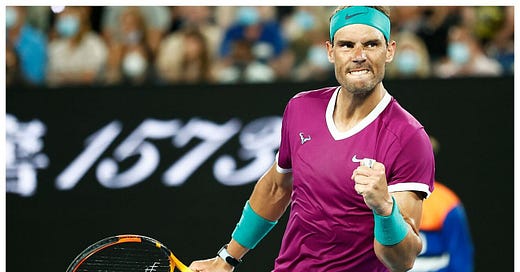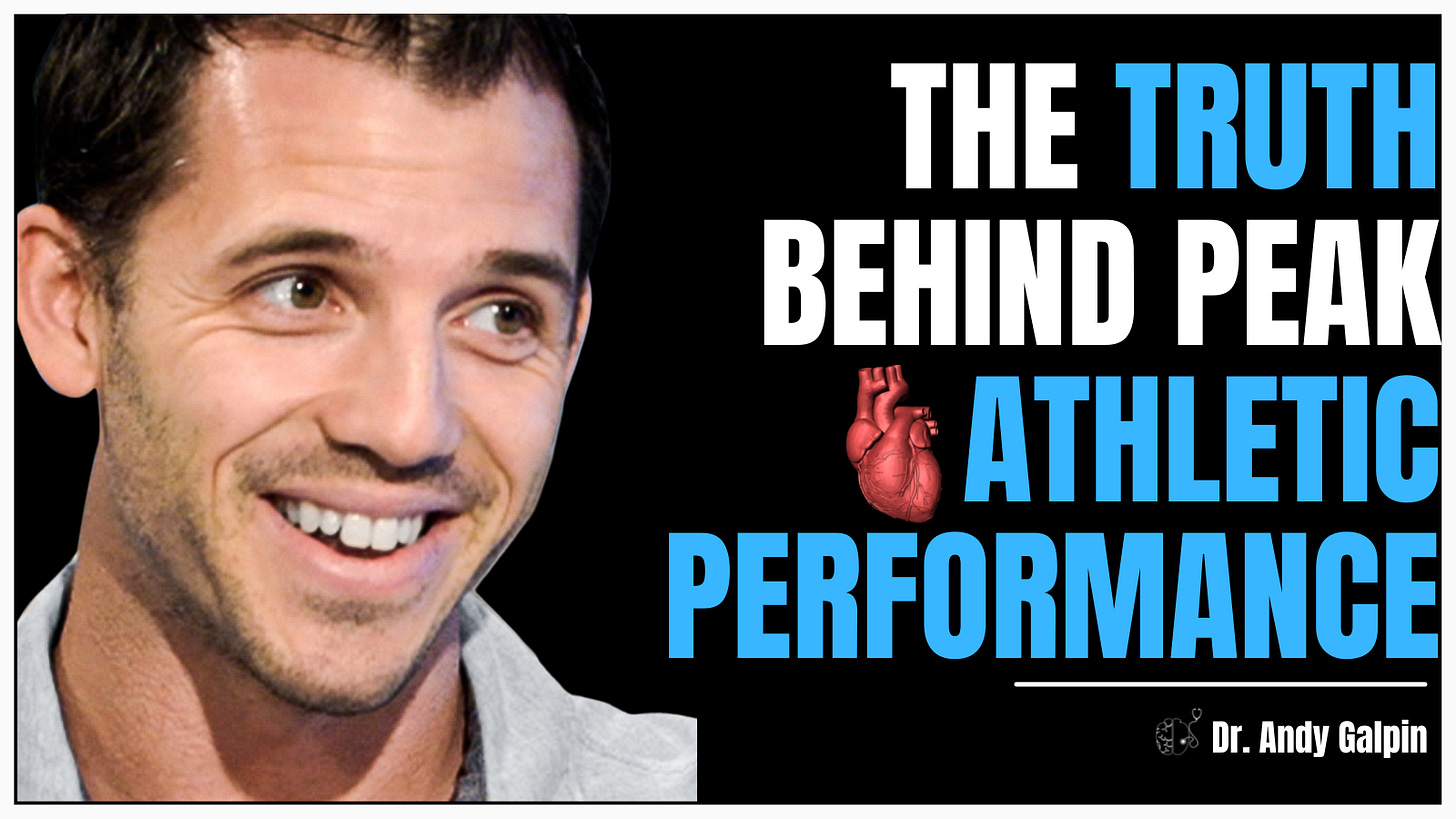The Rafa Mentality: How to Perform Under Pressure
Peak performance is a function of a still mind.
Neuro Athletes,
Please tell me you stayed up to watch the Australian Open? The chills running down my spine while I sit here with the highlights in the background writing to you all feels so surreal. If you did watch it and you’re wondering how Nadal made a comeback after hours on the court, then you are in the right place. When you're a pro tennis player, keeping your "eye on the ball" isn't just an inspirational motto, it's also, like, the only way to get from "love" to "game." The message of this newsletter is simple. Focus, focus of attention in the present moment, the only one you can really live in is at the heart of this newsletter, and at the heart of the art of doing anything well.
Btw...if you were forwarded this newsletter, or you’re not a current subscriber, join 35,000+ individuals who subscribe to Neuro Athletics. It takes 3.2 seconds to click here and subscribe. Every week, I go deep into a topic that you can use and implement into your routine to upgrade your mental performance.
…..neuroscience reveals that remaining calm under pressure is not an inborn trait, but a skill that anybody can learn.
Here's how it's done 👇
This email is brought to you by
Primer:
An athlete could spend many years developing and honing their skill sets to reach an elite level. But the best skills in the world are not valuable if athletes cannot perform in them when it matters most. For instance, when all eyes are on LeBron James as he attempts to score that game-winning free throw in a match against the Wizards. Or when an exhausted Rafael Nadal is down two sets to Daniil Medvedev in the AO finals to come back and serve out his fairytale comeback win 2-6 6-7 6-4 6-4 7-5 — sending Rod Laver Arena into pandemonium. Whether the athlete fumbles or graces under pressure, it comes down to how they channel their anxiety when the pressure mounts.
Some could argue that pressure comes from an inability to focus when pressure builds up. This may be because focus means not dwelling on the past, either on mistakes or glories. It means not being so caught up in the future, either its fears or its dreams. The ability to focus the mind is the ability to not let it run away with you. It does not mean not to think, but to be the one who directs your own thinking in times of need.
Neuroscience of Pressure
All of the things you experience when you are under pressure to perform, like the brain fog or the desire to cry, are likely tied to your prefrontal cortex. However the feeling of pressure stems from the fight-or-flight response that occurs in our body in response to a threat. It begins when a part of our brain called the amygdala—which controls emotions—interprets a situation as a threat. This perception triggers the brain to release neurochemicals like adrenaline that instructs the nervous system to prepare the body for drastic measures—heart rate increases, breath shortens, blood flows to the muscles, and peripheral vision fades to produce a tunnel vision. In other words, the body becomes active while the mind becomes focused.
Why Athletes Choke Under Pressure
The part of the brain that helps us to focus is called the prefrontal cortex. And located in the prefrontal cortex is the working memory—which refers to the ability to hold and work with numerous ideas and concepts in the mind simultaneously.
In the athletic context, it helps athletes to process and comprehend what is going on during the game. This, in turn, allows them to continuously change and adapt their own game plan while also predicting their competitors' moves.
In pressured situations, athletes often develop an anxious desire to succeed. In times like this, rather than focusing on the crucial elements, anxiety can sometimes lead the prefrontal cortex to focus on irrelevant sights and aspects during the game.
For example, the consequences of losing the match (i.e., distraction) or the technical execution of the skill (e.g., arm movement when swinging the golf club), which should have generally become automated and controlled without conscious effort (i.e., self-focus).
This causes the athlete to miss out on critical information while burdening the working memory with irrelevant ones. As a result, their ability to strategize and perform is disrupted and they choke.
The Rafa Mentality
When the pressure kicks in, whether an athlete thrives or chokes typically depends on how they perceive the situation—a challenge or a threat.
Tackling it point by point - one of the greatest tricks in tennis is whether you are about to win or have to serve the second serve in the tie-break of the decisive set to stay in the match.
In a post match interview, Rafael Nadal said "You often talk too much about mentality. But when you usually win, it's because of how you handle the ball, and then only because of mental aspects”.
Athletes like Nadal who view the game as a challenge can often maintain composure and high levels of confidence. And with the extra energy and a sharpened concentration, they can utilize the full capacity of their working memory to analyze an on-court situation, formulate and execute the best strategy in real-time, hence helping them to thrive under pressure.
On the contrary, athletes who view it as a threat are often overwhelmed by anxiety. This often instills in them the urge to speed things up and get past that situation quickly, which eventually causes the athlete to lose control, misjudge the situation, and fumble under pressure.
Tiger Woods, one of the greatest golfers of all time, once said, “it’s pressure, there’s no doubt. I was nervous and that’s a good thing. That means you care. You can try and use that energy as best you can to heighten your focus and then get into the right situation and it worked out great for me this week.”
While most people run from pressure, great champions learn to run to and through it. It challenges them and forces them to grow, to improve. Concentrate on breathing, focus on the process, focus on this very moment and performing each current skill as perfectly as possible and trust in your preparation.
L-theanine’s Impact on Stress and Anxiety: Human Studies
This wouldn’t be a Neuro Athletics newsletter without mentioning some actionable tools to help with the content above. Although we went into the weeds of psychological performance, I thought it would be a good idea to look at supplementation to help with calming down the nervous system.
A recent 2016 systematic review looked at all available human clinical trials that examined the effects of supplemental L-theanine consumption (200-400 mg/day) on stress and anxiety. Of the five randomized controlled trials, four trials found that L-theanine was associated with reduced stress and anxiety in people experiencing stressful situations. However, these studies only looked at those experiencing acute stress, and more research is needed to evaluate L-theanine’s impact on chronic stress.
One randomized control trial showed particular promise for the future of L-theanine research. The study followed 30 healthy adults who were given either L-theanine (200 mg/day) or a placebo for four weeks. Stress-related symptoms and state-trait anxiety scores—anxiety about an event (state), or anxiety level as a personal characteristic (trait)—decreased significantly following L-theanine administration compared to the placebo. These findings demonstrate L-theanine’s potential to promote mental health in the general population facing stress-related ailments.
That’s it for this week! I really hope you enjoyed this newsletter, if you did please feel free to comment or share this along to someone who you think could benefit.
Until next time,
Louisa x
This Week On The Neuro Experience Podcast
Dr Andy Galpin is a tenured professor in the Center for Sport Performance at Cal State Fullerton. Andy is an expert in muscle biology/physiology in particular muscle fiber types.
In this episode you will learn:
1. Science of VO2 MAX testing for the athlete and for the general population
2. Blood Tests- what tests to order and what to look for
3. Why the most important person isn't the one who takes your blood or puts you through a test, it's the person who analyses it.
4. Sunlight and vitamin D - the truth
5. Biggest mistakes in the fitness industry in 2022.
6. Neuro Athletics- brain optimisation/ cognitive performance
7. How Andy's program starts- baseline measurements
8. Sleep science
9. Technology and wearables
Improve Your Fitness Through Sleep
Firstly, have you entered the Pod Pro giveaway? If not, be sure to go to Instagram and follow the instructions. If you prefer to skip the competition and want to dive into better sleep immediately, here are some pro’s of sleeping on this type of tech:
You can be sleeping as cool as 55°F or as hot as 110°F.
The temperature of the Pod Pro will adjust each side of the bed based on your sleep stages, biometrics, and bedroom temperature, reacting intelligently to create the optimal sleeping environment.
I have been away in Australia and my REM sleep has been suffering without my Eight Sleep. The Pod Pro by Eight Sleep is so popular, it has garnered attention from CEOs, pro athletes, and overall high performers who want to get sleep fit. Because good sleep is the ultimate game changer.







